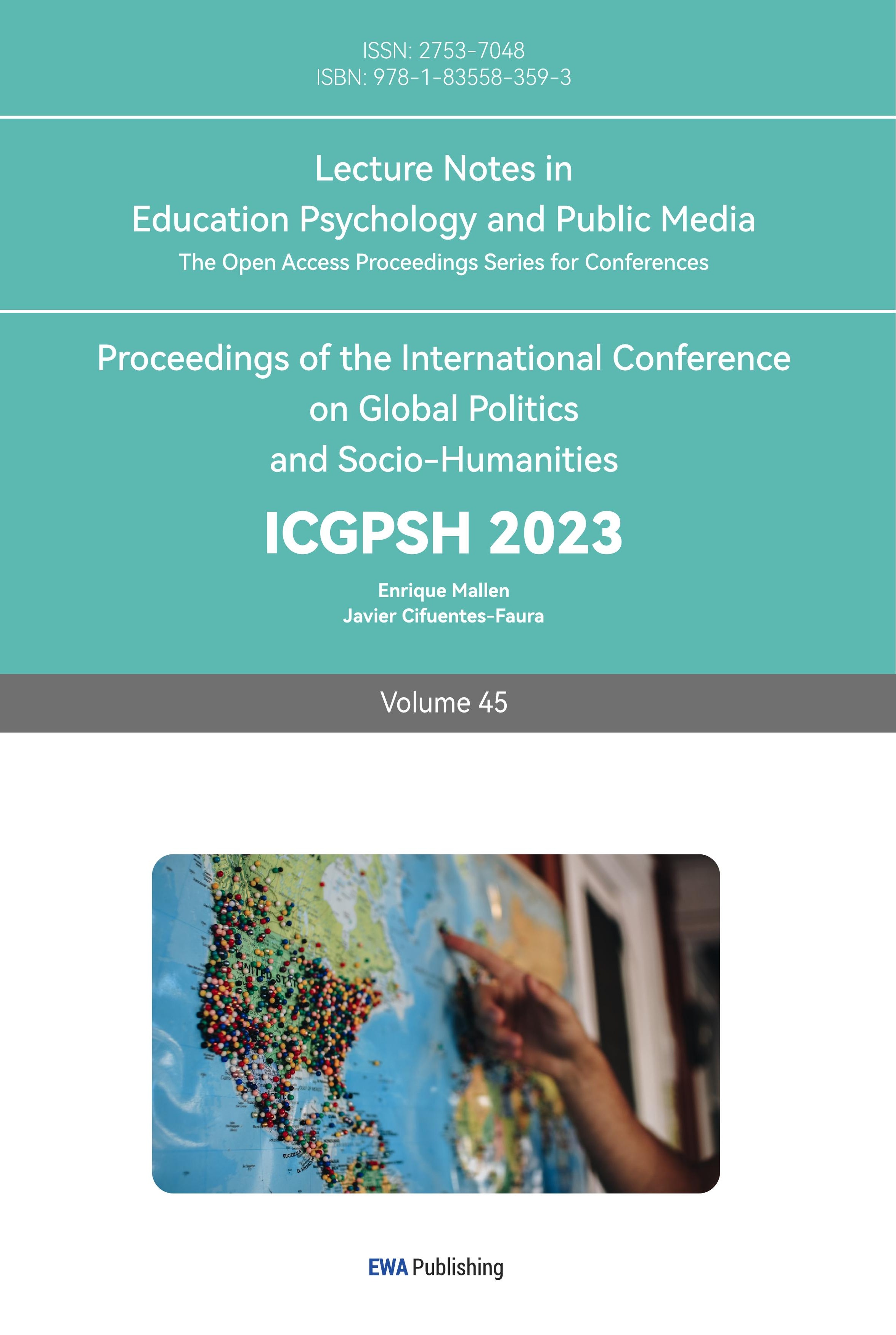References
[1]. Chin, H. K. K. (2005). Open doors: Report on international educational exchange. New York, NY: Institute of International Education (IIE).
[2]. Institute of International Education. (2020). Open doors® 2019 Fast Facts. https://opendoorsdata.org/fast_facts/fast facts-2019/
[3]. Quinton, W. J. (2019). Unwelcome on campus? Predictors of prejudice against international students. Journal of Diversity in Higher Education, 12(2), 156– 169.
[4]. Ellemers, N., Van Rijswijk, W., Roefs, M., & Simons, C. (1997). Bias in intergroup perceptions:Balancing group identity with social reality. Personality and Social Psychology Bulletin, 23, 186–198.
[5]. Ellemers, N., van Dyck, C., Hinkle, S., & Jacobs, A. (2000). Intergroup differentiation in socialcontext: Identity needs versus audience constraints. Social Psychology Quarterly, 63, 60–74.
[6]. Branthwaite, A., & Jones, J. E. (1975). Fairness and discrimination: English versus Welsh. European Journal of Social Psychology, 5(3), 323–338.
[7]. Falk, C. F., Heine, S. J., & Takemura, K. (2013). Cultural variation in the minimal group effect. Journal of Cross-Cultural Psychology, 45(2), 265–281.
[8]. Greive, P. G., & Hogg, M. A. (1999). Subjective uncertainty and intergroup discrimination in the minimal group situation. Personality and Social Psychology Bulletin, 25.
[9]. Yamagishi, T., & Mifune, N. (2008). Does shared group membership promote altruism? Fear, greed, and reputation. Rationality and Society, 20, 5-30.
[10]. Bornstein, G., Crum, L., Wittenbraker, J., Harring, K., Insko, C. A., & Thibault, J. (1983). On the measurement of social orientations in the minimal group paradigm. European Journal of Social Psychology, 13.
[11]. Gaertner, L., & Insko, C. A. (2001). On the measurement of social orientations in the minimal group paradigm: Norms as moderators of the expression of intergroup bias. European Journal of Social Psychology, 31.
[12]. Houston, Diane M., and Alexia Andreopoulou. (2010). Test of Both Corollaries of Social Identity Theory’s Self-Esteem Hypothesis in Real Group Settings. British Journal of Social Psychology, 42.
Cite this article
Chen,X. (2024). Ingroup Bias and Collective Self-esteem of Chinese International Students. Lecture Notes in Education Psychology and Public Media,45,123-126.
Data availability
The datasets used and/or analyzed during the current study will be available from the authors upon reasonable request.
Disclaimer/Publisher's Note
The statements, opinions and data contained in all publications are solely those of the individual author(s) and contributor(s) and not of EWA Publishing and/or the editor(s). EWA Publishing and/or the editor(s) disclaim responsibility for any injury to people or property resulting from any ideas, methods, instructions or products referred to in the content.
About volume
Volume title: Proceedings of the International Conference on Global Politics and Socio-Humanities
© 2024 by the author(s). Licensee EWA Publishing, Oxford, UK. This article is an open access article distributed under the terms and
conditions of the Creative Commons Attribution (CC BY) license. Authors who
publish this series agree to the following terms:
1. Authors retain copyright and grant the series right of first publication with the work simultaneously licensed under a Creative Commons
Attribution License that allows others to share the work with an acknowledgment of the work's authorship and initial publication in this
series.
2. Authors are able to enter into separate, additional contractual arrangements for the non-exclusive distribution of the series's published
version of the work (e.g., post it to an institutional repository or publish it in a book), with an acknowledgment of its initial
publication in this series.
3. Authors are permitted and encouraged to post their work online (e.g., in institutional repositories or on their website) prior to and
during the submission process, as it can lead to productive exchanges, as well as earlier and greater citation of published work (See
Open access policy for details).
References
[1]. Chin, H. K. K. (2005). Open doors: Report on international educational exchange. New York, NY: Institute of International Education (IIE).
[2]. Institute of International Education. (2020). Open doors® 2019 Fast Facts. https://opendoorsdata.org/fast_facts/fast facts-2019/
[3]. Quinton, W. J. (2019). Unwelcome on campus? Predictors of prejudice against international students. Journal of Diversity in Higher Education, 12(2), 156– 169.
[4]. Ellemers, N., Van Rijswijk, W., Roefs, M., & Simons, C. (1997). Bias in intergroup perceptions:Balancing group identity with social reality. Personality and Social Psychology Bulletin, 23, 186–198.
[5]. Ellemers, N., van Dyck, C., Hinkle, S., & Jacobs, A. (2000). Intergroup differentiation in socialcontext: Identity needs versus audience constraints. Social Psychology Quarterly, 63, 60–74.
[6]. Branthwaite, A., & Jones, J. E. (1975). Fairness and discrimination: English versus Welsh. European Journal of Social Psychology, 5(3), 323–338.
[7]. Falk, C. F., Heine, S. J., & Takemura, K. (2013). Cultural variation in the minimal group effect. Journal of Cross-Cultural Psychology, 45(2), 265–281.
[8]. Greive, P. G., & Hogg, M. A. (1999). Subjective uncertainty and intergroup discrimination in the minimal group situation. Personality and Social Psychology Bulletin, 25.
[9]. Yamagishi, T., & Mifune, N. (2008). Does shared group membership promote altruism? Fear, greed, and reputation. Rationality and Society, 20, 5-30.
[10]. Bornstein, G., Crum, L., Wittenbraker, J., Harring, K., Insko, C. A., & Thibault, J. (1983). On the measurement of social orientations in the minimal group paradigm. European Journal of Social Psychology, 13.
[11]. Gaertner, L., & Insko, C. A. (2001). On the measurement of social orientations in the minimal group paradigm: Norms as moderators of the expression of intergroup bias. European Journal of Social Psychology, 31.
[12]. Houston, Diane M., and Alexia Andreopoulou. (2010). Test of Both Corollaries of Social Identity Theory’s Self-Esteem Hypothesis in Real Group Settings. British Journal of Social Psychology, 42.









